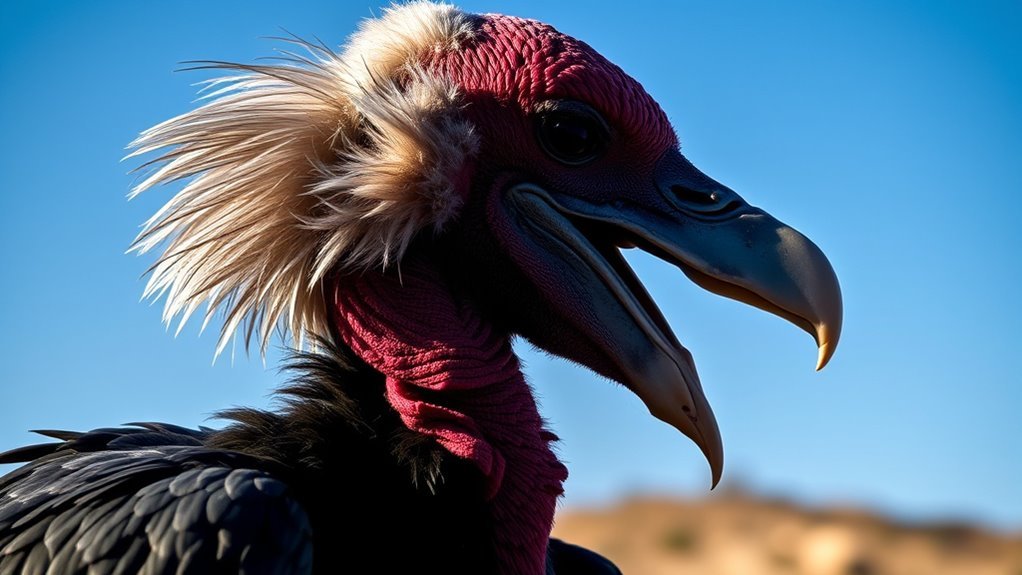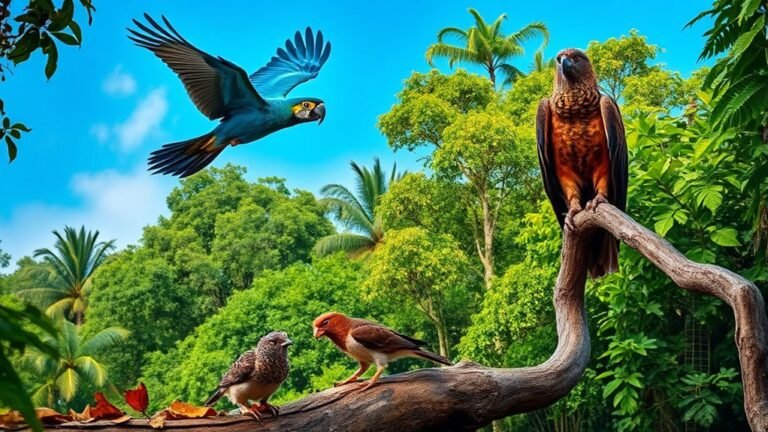The Reason Behind Vultures’ Bald Heads
Vultures have bald heads for important reasons related to their scavenging habits. The lack of feathers helps keep their heads clean by reducing bacteria when they feed on dead animals. This cleanliness is crucial for their health. Additionally, bald heads help vultures regulate their body temperature, allowing them to manage heat better while foraging in warm environments.
These adaptations are not just practical; they also enhance social interactions among vultures. The bare skin can signal readiness to feed or communicate with other vultures. Understanding these features shows how vultures have adapted to thrive as scavengers in their ecosystems.
Key Takeaways
- Bald heads in vultures reduce bacterial trapping, enhancing their cleanliness while feeding on decaying materials.
- The absence of feathers minimizes infection risks, supporting hygiene and overall health during scavenging.
- Bald skin promotes efficient thermoregulation, allowing vultures to release heat in hot environments.
- Vultures' baldness reduces exposure to parasites, offering a health advantage while foraging.
- The bare skin facilitates social interactions, strengthening bonds and communication within vulture groups.
The Evolutionary Origins of Bald Heads in Vultures

Vultures are often seen as unattractive scavengers, but their bald heads serve important practical purposes. The absence of feathers on their heads provides key benefits for their feeding habits.
When vultures eat carrion, feathers could trap bacteria and decaying materials, which can lead to health problems. Vultures with bald heads have a better survival rate because they're less likely to get infections. This trait helps them stay clean and improves their ability to find food quickly.
Hygiene and Scavenging: Why Bare Skin Is Beneficial
Vultures have bare skin, which helps them stay clean while scavenging. Their skin is easier to wash than feathers, reducing the chance of bacteria and germs from dead animals. This cleanliness allows vultures to eat quickly without worrying about getting sick.
Without feathers, there's also less chance of infections from debris getting trapped. By having bare heads and necks, vultures can easily reach their food and clean off any mess.
This adaptation helps them stay healthy and allows them to play their important role in nature as scavengers, keeping the environment clean.
Thermoregulation: Keeping Cool in Hot Environments

Vultures fly high over dry landscapes, and their bare heads and necks help them stay cool. These birds use simple strategies to regulate their body temperature in extreme heat. The absence of feathers on their heads promotes better heat loss as they look for food.
Here are some ways vultures manage their body temperature:
- Exposing bare skin helps them lose heat quickly.
- Soaring high gives them access to cooler air.
- Panting helps them release extra heat.
- Bathing cools them down on hot days.
- Limiting activity during peak heat hours keeps them safe.
These traits show how well vultures adapt to tough environments, highlighting the power of nature.
Reducing Parasite Load: The Role of a Bald Head
Vultures have bald heads. This feature helps them regulate their body temperature.
It also reduces their exposure to parasites. Without feathers, vultures limit the chance of harmful insects and germs finding a home on their skin.
This simple design gives vultures an advantage in staying healthy while they scavenge for food. Their unique heads play a key role in keeping them efficient and strong in their environment.
Social Interactions and Communication Among Vultures

Vultures often appear to scavenge alone, but they actually engage in important social interactions. These interactions help them survive in their environment.
Vulture communication establishes social order and organizes how they feed. Here are some behaviors that show their social connections:
- Vocal sounds to alert others or signal danger
- Body movements to show authority or submission
- Shared foraging strategies to find food together
- Preening to build strong bonds
- Grooming each other to create friendships
Understanding these behaviors can increase your appreciation for vultures. Their social structure helps them use resources wisely and fosters a sense of community.
This insight connects you to a fascinating aspect of animal life.
Feather Loss and Adaptation to Feeding Habits
Vultures face specific challenges while scavenging for food that influence their feather loss and adaptations. Their bald heads are key to their feeding success.
Feathers can hold bacteria and decay, which makes vultures vulnerable to illness. By losing these feathers, vultures improve their chances of survival in their environment. This adaptation lets them dive into decaying carcasses without the risk of contaminated feathers.
Additionally, their bare skin is easier to clean, which helps them stay hygienic after feeding. As nature's cleanup crew, vultures show how losing feathers can enhance their feeding habits and enable them to thrive in ecosystems where other animals struggle.
Recognizing this adaptation helps us appreciate these incredible birds.
Comparative Analysis: Bald Heads in Other Scavengers
Bald heads are common among scavengers, not just vultures. Other birds like crows also display this feature, which helps them while feeding.
Crows have fewer feathers on their heads to keep clean and healthy as they eat.
Here are some examples of scavengers with bald heads:
- Turkey Vultures: Their bare skin helps them stay clean during meals.
- Bald Eagles: The lack of feathers around their heads supports hygiene while feeding.
- California Condors: Their baldness helps prevent germs when eating carrion.
- Hyenas: Less fur on their faces allows for quicker feeding.
- Certain Ravens: Their behavior focuses on efficient scavenging and cleanliness.
Each of these species provides interesting insights into how they survive in their environments.
Understanding these adaptations can enhance your knowledge of different scavenger species.
Frequently Asked Questions
Do All Vulture Species Have Bald Heads?
Not all vulture species have bald heads. Many vultures, however, do possess this feature. Different vulture species show a variety of traits. These adaptations help them survive in different habitats and fulfill important roles in the ecosystem. Vultures are essential for maintaining environmental health by feeding on dead animals. This characteristic makes them valuable to nature.
How Do Vultures Clean Their Bald Heads?
Vultures keep their bald heads clean by bathing in water or dust. This process helps remove bacteria and parasites from their skin. Keeping their heads clean is important for their health and survival in the wild.
Are There Any Environmental Threats to Vultures?
Vulture populations face serious threats from habitat loss and environmental changes. These factors contribute to their decline. It is important to protect their ecosystems. By doing so, we help maintain biodiversity and support these vital scavengers. Preserving their habitats is essential for their survival.
What Do Vultures Eat Besides Carrion?
Vultures mainly eat carrion, but they also consume small animals, fruits, and insects. Their diet shows they can adjust to different environments. This adaptability helps them find food even when it's scarce. Vultures play an essential role in the ecosystem by cleaning up dead animals. Their unique eating habits make them interesting and important birds in nature.
How Long Do Vultures Typically Live?
Vultures typically live between 10 to 30 years. Their lifespan varies based on species and environment. This longevity shows their ability to adapt and survive in changing habitats and food conditions.

Hello, I’m Emily Price, the founder of Birds Affection. As a passionate bird enthusiast and spiritual seeker, I’ve always been fascinated by the symbolic meanings and mystical connections between birds and our lives. On this website, I share my knowledge and insights on the spiritual significance of various bird species, exploring their roles as messengers, guides, and teachers. Through my writing, I aim to inspire and educate others on the profound wisdom and beauty that birds bring to our world. Join me on this journey as we delve into the enchanting realm of bird symbolism and discover the hidden meanings behind these magnificent creatures.






